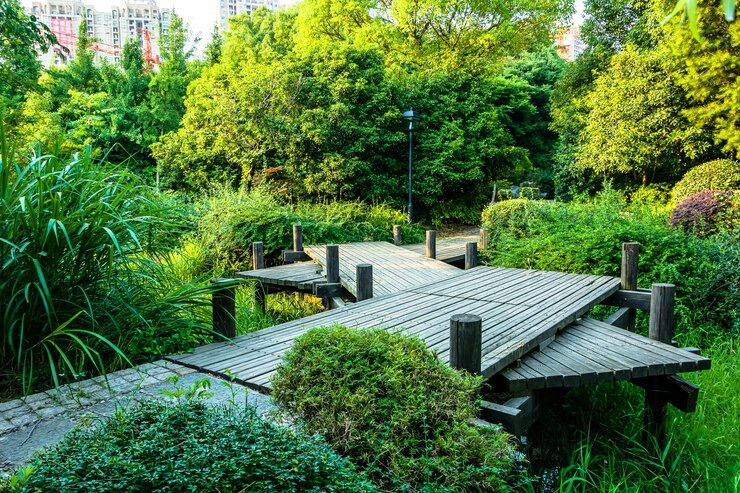In the global embrace of sustainable living, the construction industry is evolving, placing eco-friendly practices at the forefront, notably in sustainable landscaping.
The integration of sustainable landscape methods in construction isn’t merely an eco-conscious choice; it’s a strategic move aligned with the escalating focus on environmentally friendly development. This approach involves utilizing native flora, water-efficient irrigation, and permeable materials, reducing water runoff and enhancing biodiversity.
Not only does it curb the environmental impact of construction, but it also fosters long-term resource preservation.
Incorporating elements like permeable paver systems and the enticing appeal of thermally modified wood, along with the principles guiding sustainable landscape design, such as green roofs, rain gardens, and energy-efficient outdoor lighting, construction projects can fashion spaces that serve immediate needs while seamlessly blending with nature, nurturing ecological equilibrium and resilience.
Table of Contents
Permeable Paver Systems: Sustaining Water Management
Permeable paver systems are reshaping the landscape of construction projects by revolutionizing water management. In contrast to traditional impermeable surfaces, these innovative systems introduce void spaces between units, allowing rainwater to gently infiltrate the surface.
This departure from impermeable surfaces addresses critical environmental challenges associated with stormwater runoff, diminished groundwater recharge, and increased flood risk.
Permeable pavers mitigate the impact of stormwater runoff, fostering sustainable water practices. They support groundwater recharge by allowing rainwater to percolate through the surface, contributing to the sustainable use of groundwater resources.
In urban areas, impermeable surfaces exacerbate the heat island effect. Permeable pavers, by facilitating water absorption, regulate surface temperatures, improving the comfort of outdoor spaces and aligning with the goal of creating environmentally sustainable built environments.
Beyond functionality, permeable paver systems offer creative design options, providing architects and designers with flexibility. They come in various shapes, colors, and patterns, allowing for the integration of sustainable water management practices without compromising aesthetics.
This merging of functionality and design underscores the adaptability and versatility of permeable paver systems in construction projects.
Permeable pavers act as a natural barrier to erosion, slowing down runoff and preserving the integrity of surrounding ecosystems. Their water filtration process improves water quality, removing pollutants and contributing to the health of local ecosystems.
Compliance with environmental regulations is ensured, making permeable paver systems not just a technical solution but a commitment to responsible environmental practices in construction.
In essence, permeable paver systems are more than a technical solution to water management; they represent a commitment to responsible environmental practices.
Through their multifaceted contributions, permeable paver systems redefine outdoor spaces, creating environments that thrive in harmony with nature and exemplify the principles of sustainable construction.
Thermally Modified Wood: Beauty with Sustainability

Thermally modified wood is reshaping sustainable landscaping in construction projects by providing an environmentally friendly alternative to traditional wood materials.
Through a process of heat treatment, this wood gains enhanced durability, reducing its susceptibility to decay, insects, and fungal growth. The result is a prolonged lifespan for landscaping elements, diminishing the need for frequent replacements and lessening the overall demand on natural resources.
One notable sustainable aspect is the reduced reliance on chemical preservatives. Unlike traditional wood treatments involving chemical agents, thermally modified wood’s process utilizes heat, mitigating potential environmental and health concerns associated with chemical treatments.
Energy efficiency is a key feature of thermally modified wood, requiring less energy during production compared to alternative wood treatment methods. This lower energy consumption contributes to a smaller carbon footprint, aligning with the overarching goals of sustainable construction.
Beyond its eco-friendly attributes, thermally modified wood offers aesthetic appeal and versatility. The process results in a rich, consistent color and texture, making it a popular choice for various landscaping elements, including decking, fencing, and outdoor furniture.
The wood’s enhanced appearance over time reduces the need for frequent replacements, promoting sustainability by minimizing the demand for new materials.
Crucially, thermally modified wood is often sourced from sustainably managed forests or certified forestry operations. This responsible wood sourcing contributes to the preservation of ecosystems and biodiversity, aligning with broader environmental conservation efforts.
In essence, thermally modified wood is a sustainable cornerstone in landscaping for construction projects, balancing durability, reduced chemical impact, energy efficiency, aesthetic appeal, and responsible wood sourcing practices.
Its incorporation into landscaping designs allows construction projects to contribute to a more sustainable built environment, where outdoor spaces seamlessly integrate functional and aesthetic requirements with a steadfast commitment to environmental responsibility.
Principles of Sustainable Landscape Design: Harmony with Nature

The principles of sustainable landscape design play a vital role in enhancing construction projects, fostering environmental responsibility, and creating outdoor spaces that seamlessly blend with the natural environment. Native plant selection supports biodiversity, reduces maintenance requirements, and promotes a healthier landscape.
Water conservation practices, such as efficient irrigation systems and rainwater harvesting, optimize water usage and contribute to sustainable water management.
Energy-efficient lighting solutions, particularly LED fixtures, not only reduce energy consumption but also enhance safety and security in outdoor spaces.
Preserving natural habitats around construction projects supports ecosystem services and ecological balance, contributing to a resilient landscape. Sustainable landscape design principles minimize soil erosion, reduce chemical dependency, and promote a healthier soil structure.
Beyond the environmental benefits, sustainable landscape design enhances the aesthetic appeal of outdoor spaces associated with construction projects.
Visually pleasing landscapes contribute to the overall attractiveness of projects and provide recreational opportunities, improving the quality of life for users. Positive public perception of sustainability in landscaping aligns with community values, potentially attracting more interest and support.
Embracing Ecological Imperatives: The Vital Role of Sustainable Landscaping in Construction Projects
As construction projects evolve to meet the demands of a sustainable future, the choices made in landscaping play a pivotal role.
By embracing the benefits of permeable paver systems, appreciating the beauty of thermally modified wood, and adhering to the principles of landscape design, professionals can create outdoor spaces that are not only visually stunning but also ecologically responsible. It’s a commitment to a greener, more sustainable future, one construction project at a time.
Discover the newest trends in architectural design or initiate your home renovation and construction journey with our abundant knowledge, practical guides, and insights from industry experts. Explore the world of cutting-edge architectural trends or kickstart your remodeling adventure by visiting our website at https://constructionhow.com/.





